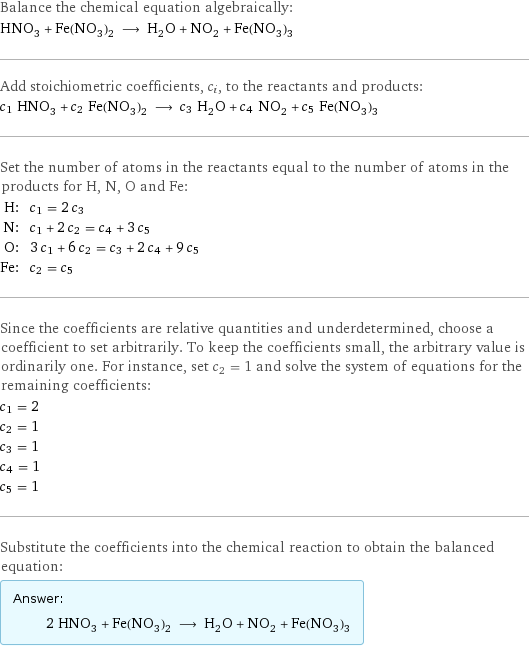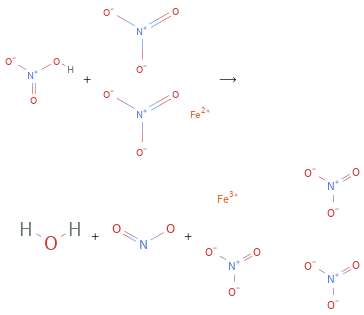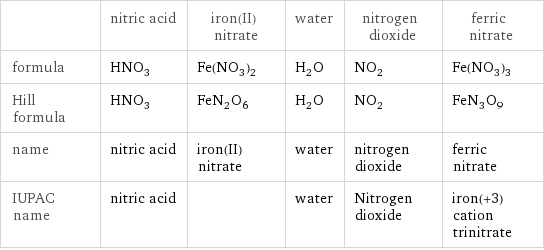Input interpretation

HNO_3 (nitric acid) + Fe(NO_3)_2 (iron(II) nitrate) ⟶ H_2O (water) + NO_2 (nitrogen dioxide) + Fe(NO_3)_3 (ferric nitrate)
Balanced equation

Balance the chemical equation algebraically: HNO_3 + Fe(NO_3)_2 ⟶ H_2O + NO_2 + Fe(NO_3)_3 Add stoichiometric coefficients, c_i, to the reactants and products: c_1 HNO_3 + c_2 Fe(NO_3)_2 ⟶ c_3 H_2O + c_4 NO_2 + c_5 Fe(NO_3)_3 Set the number of atoms in the reactants equal to the number of atoms in the products for H, N, O and Fe: H: | c_1 = 2 c_3 N: | c_1 + 2 c_2 = c_4 + 3 c_5 O: | 3 c_1 + 6 c_2 = c_3 + 2 c_4 + 9 c_5 Fe: | c_2 = c_5 Since the coefficients are relative quantities and underdetermined, choose a coefficient to set arbitrarily. To keep the coefficients small, the arbitrary value is ordinarily one. For instance, set c_2 = 1 and solve the system of equations for the remaining coefficients: c_1 = 2 c_2 = 1 c_3 = 1 c_4 = 1 c_5 = 1 Substitute the coefficients into the chemical reaction to obtain the balanced equation: Answer: | | 2 HNO_3 + Fe(NO_3)_2 ⟶ H_2O + NO_2 + Fe(NO_3)_3
Structures

+ ⟶ + +
Names

nitric acid + iron(II) nitrate ⟶ water + nitrogen dioxide + ferric nitrate
Equilibrium constant
![K_c = ([H2O] [NO2] [Fe(NO3)3])/([HNO3]^2 [Fe(NO3)2])](../image_source/9f5639e9cd1b9f72b13540f11cbe8db0.png)
K_c = ([H2O] [NO2] [Fe(NO3)3])/([HNO3]^2 [Fe(NO3)2])
Rate of reaction
![rate = -1/2 (Δ[HNO3])/(Δt) = -(Δ[Fe(NO3)2])/(Δt) = (Δ[H2O])/(Δt) = (Δ[NO2])/(Δt) = (Δ[Fe(NO3)3])/(Δt) (assuming constant volume and no accumulation of intermediates or side products)](../image_source/cfb811e7e6183028327f645b3cd790f7.png)
rate = -1/2 (Δ[HNO3])/(Δt) = -(Δ[Fe(NO3)2])/(Δt) = (Δ[H2O])/(Δt) = (Δ[NO2])/(Δt) = (Δ[Fe(NO3)3])/(Δt) (assuming constant volume and no accumulation of intermediates or side products)
Chemical names and formulas

| nitric acid | iron(II) nitrate | water | nitrogen dioxide | ferric nitrate formula | HNO_3 | Fe(NO_3)_2 | H_2O | NO_2 | Fe(NO_3)_3 Hill formula | HNO_3 | FeN_2O_6 | H_2O | NO_2 | FeN_3O_9 name | nitric acid | iron(II) nitrate | water | nitrogen dioxide | ferric nitrate IUPAC name | nitric acid | | water | Nitrogen dioxide | iron(+3) cation trinitrate